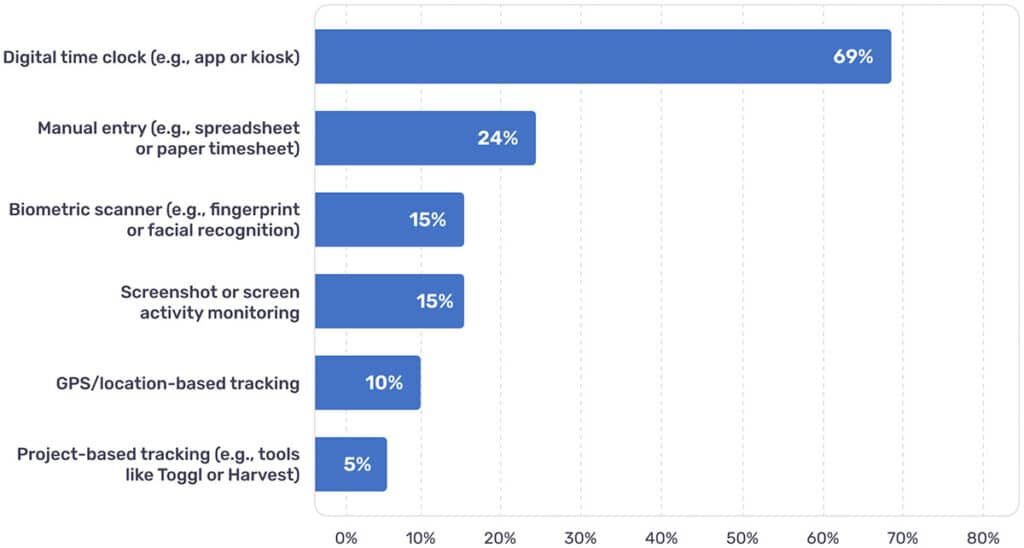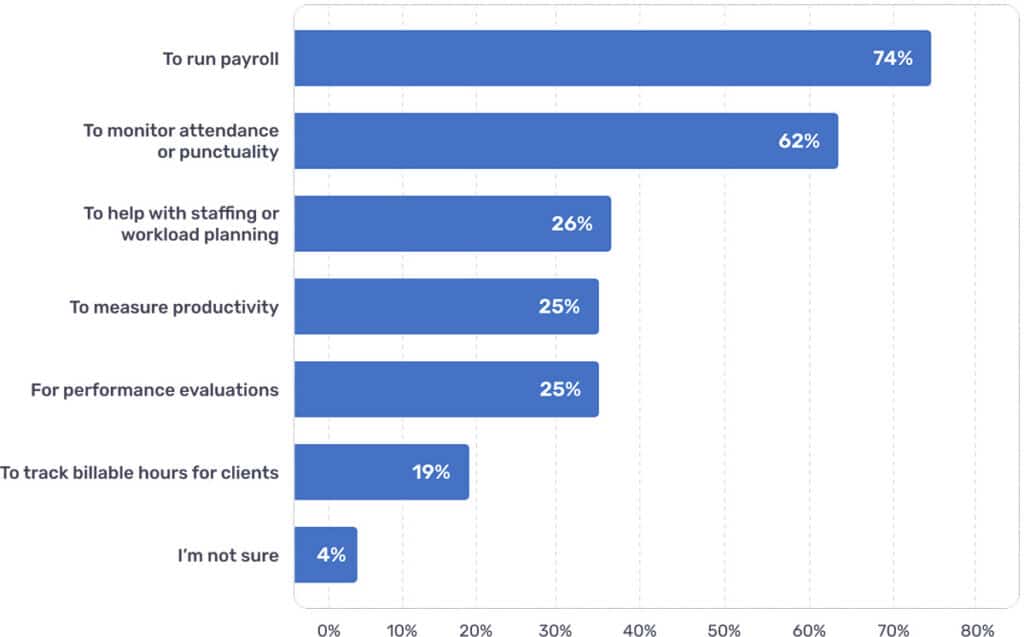
Time Tracking and Trust:What Today’s Employees Really Think

By Eric Czerwonka
Tracking Time Without Losing Trust
For most workers, time tracking is unavoidable… a fact of life. In today’s hybrid-heavy work environment, organizations face a lot of pressure to monitor attendance, productivity, and workloads. Indeed, one national survey found that about 61% of employees say their employer uses time and attendance monitoring, showing just how routine this practice has become.
Whether it’s tapping a digital clock on a phone or filling out a spreadsheet at the end of a shift, recording hours is standard practice across industries. But behind that routine lies a reality companies can’t ignore: time tracking can either reinforce fairness and trust… or erode them. Over 40% of professionals say employer monitoring actually reduces their productivity, underscoring that monitoring isn’t just a tech solution; it’s a human challenge that demands clear policies and trust-building.
These stakes make clear communication and thoughtful design more important than ever. Buddy Punch’s 2025 survey of over 500 non-managerial U.S. workers reveals a complex reality: most employees see time tracking as helpful for ensuring accurate pay and clear expectations, but many also view it as surveillance or a source of stress and confusion, especially when systems are poorly communicated or designed.
Key Findings
- Most employees see time tracking as helpful in general (75%) and valuable for keeping things fair for all employees (77%) and for clarifying expectations (68%).
- Just over three-quarters (76%) of respondents trust their employer to use tracking data fairly and 82% think that their employer uses time tracking to support their employees rather than control them.
- Almost one-third (30%) of employees say time tracking makes them feel under surveillance.
- More than a quarter (26%) say it adds stress or pressure to their workday.
- Clear communication, equal rules, easy-to-use systems, and employee input are essential for making time tracking feel fair and trustworthy, with 55% valuing ease of use, 53% wanting equal rules, and 47% wanting access to their own records.
These findings highlight what employees want from time-tracking systems, and what risks can arise when those expectations aren’t met. Time tracking works best when it’s clear, fair, consistent, and built with employees in mind. This blog explores what workers say builds trust versus what feels like micromanagement and how companies can get it right.
How Employees Track Time
According to our survey, digital time clocks dominate the landscape, with nearly seven in ten workers saying they use an app, kiosk, or automated system to track their time at work. This shift reflects the push to move beyond old-school timesheets toward AI-powered systems that reduce repetitive data entry, improve accuracy, and give leaders real-time insights for better planning.
Still, about a quarter of employees in the survey say they rely on manual entry like spreadsheets or paper forms. Interestingly, younger workers (18 to 34) are more likely than older employees to use manual methods, with over a third reporting this approach. This age difference might reflect that younger workers are concentrated in smaller workplaces or roles where high-tech solutions aren’t yet standard.
What type of time tracking / monitoring do you use at your job?

How employees track time also varies depending on organization size and structure, highlighting how organizational priorities and resources shape the tools employees use every day. Our survey found that workers employed by a company are more likely to use digital time clocks (72%) compared to those who work in government, nonprofit, or education settings (58%). This indicates that company workplaces tend to have more standardized – but potentially more rigid – tracking systems. About one-third of smaller organizations (under 200 employees) rely on manual methods (more than double the rate of larger organizations), which may feel more flexible but can frustrate employees looking for accuracy and clarity.
“I can clock in and out on my phone. Very helpful.” – Buddy Punch Survey Respondent
Why Employers Track Time
For most organizations, payroll is the main driver behind time tracking. Nearly three-quarters of our survey’s respondents say their employer uses tracking systems to run payroll, with just over six in ten citing attendance or punctuality. This shows that time tracking is fundamentally about ensuring accurate pay, but also about maintaining accountability for when and how work gets done.
How is your time tracking/monitoring data used by your employer?

But the purpose of tracking doesn’t look the same for everyone. Customer-facing employees (like cashiers, sales associates, and support reps) and production workers are much more likely to see attendance as the main reason for tracking (66% and 67%), compared to just 47% of administrative staff. On the other hand, customer-facing workers cite staffing and workload planning at 35%, compared to 19% by those in production and 17% in administrative roles. These findings suggest that for customer-facing roles, tracking isn’t just about clocking in – it’s a tool for managing unpredictable demand and scheduling needs.
| Role Type | Attendance Tracking | Staffing/Workload Planning |
|---|---|---|
| 66% | 35% | |
| 67% | 19% | |
| 47% | 17% |
For remote and hybrid employees, the purpose often shifts even further. In one recent study, 85% of leaders reported that hybrid work led to stricter tracking and monitoring practices, suggesting growing concerns about trust in distributed environments. That aligns with our survey, which finds that remote and hybrid employees are nearly twice as likely compared to in-person workers to say tracking is used to measure productivity (41% vs. 22%). This shows how time tracking evolves in less visible work settings, shifting from monitoring presence to assessing output, and adding pressure to prove constant productivity when working outside the traditional office.
Believe That Tracking is Used to Measure Productivity
Remote and Hybrid Workers
In-person Workers
And scale matters too: workers at large organizations (1,000+ employees) are especially likely to see tracking as being used for attendance (71%). While reliable attendance is important for organizations of all sizes, larger companies may lean more on formal tracking systems to manage staffing consistently across bigger teams.
“Time tracking makes it so that you get paid for the amount of time that you actually work.” – Buddy Punch Survey Respondent
But how employees experience that tracking depends on how it’s implemented.
When Tracking Helps and When It Hurts
When implemented well, time tracking supports accountability and fairness. Most employees in our survey see real value in tracking. Three-quarters described their employer’s practices as helpful, with just 7% calling them frustrating. And a majority believe that their employer uses time tracking to support their employees rather than control them (82% vs. 58%).
of employees say tracking is helpful
of employees believe time tracking is used to support employees
“It’s a great way to not only keep track of every hour that I’ve worked but also calculates time off.” – Buddy Punch Survey Respondent
Still, even in workplaces where tracking is generally viewed positively, meaningful gaps remain. When companies focus too heavily on labor hours and detailed activity metrics, it can shift the goal from delivering real outcomes to just appearing busy, risking employee frustration and wasted effort. Nearly a third of employees (30%) in the Buddy Punch survey say that tracking feels like surveillance, over a quarter (26%) believe it adds stress or pressure, and 28% admit it has made them hesitate to take breaks when they were needed. These reactions highlight that even well-intentioned systems can fall short if they’re not designed and communicated with employees’ experiences in mind.
Remote and hybrid employees are particularly affected: 35% say tracking adds stress or pressure, compared to 24% of fully in-person workers.
These concerns are more than personal annoyance. Over 40% of professionals say that monitoring makes them less productive, especially when they’re aware of it. And a study of U.S. workers who spent some of the pandemic working remotely found that monitoring systems at the time tended to increase stress and blur work-life boundaries. Together, these findings show that when tracking feels intrusive, it can undermine the very trust and productivity employers hope to achieve.
What Builds Trust in Time Tracking
A key part of building trust is giving employees a voice, including in shaping how tracking data is used. Data collection should be seen as a trust-building opportunity; passive tracking without employee engagement can harm morale and retention. But our survey found that many workers feel left out of the process, with nearly six in ten workers reporting they have very little say or no say at all in how their tracking data is used.
Team structure plays a role. Being part of a team may naturally create more opportunities for discussion and feedback about how tracking is used. We found that employees who work on a team are more likely to have some or a lot of input (44%) compared to those working solo (32%). Age and gender matter too. Younger workers (18–34) are more likely to have a say (60%), suggesting they may be in roles or workplaces where employee input is more common. And male respondents were more likely than female respondents to report having a say (50% vs. 35%), hinting at subtle power dynamics around whose voices are heard in policy discussions.
% of Employees With a Say in Time Tracking

Team
workers

Solo
Workers

Male
respondents

Female
respondents
Beyond voice, fairness and clarity also matter. Time management should be treated as an organizational priority, not an individual burden, and companies that invest in clearer roles, better systems, and consistent communication reduce micromanagement risk and build trust. Our survey shows that when companies get time tracking right in these ways, employees recognize it. More than three-quarters (77%) say that time tracking keeps things fair for everyone, and a similar number (78%) believe that it’s appropriate for the work they do. Another 74% say it makes it easier to prove their work, and 68% report that it helps clarify expectations.
Say time tracking keeps things fair for everyone
Believe it’s appropriate for the work they do
Say it makes it easier to prove their work
Say it helps clarify expectations
“You never have to prove you are were you say you are. My company knows when I arrive and where I am.” – Buddy Punch Survey Respondent
Younger workers stand out here: 88% of 18–34-year-olds say tracking is appropriate for their work, and 83% say it helps them prove their contributions. It’s a sign that younger workers may see time tracking as a straightforward way to show they’re getting the job done, particularly given the nature of their roles.
Transparency about what’s being tracked – and why – is critical for building trust and making monitoring feel fair rather than punitive. And our findings suggest that many organizations are on the right track: just over three-quarters (76%) of respondents say they trust their employer to use tracking data fairly, and 74% feel their employer is clear about how the data is used.
“Because it’s digital, updated technology, it helps keep track of all my work time. My hours have never been miscalculated.” – Buddy Punch Survey Respondent
Taken together, these results suggest that when tracking is transparent and well-communicated, it can strengthen trust instead of undermining it. Research supports this… many employee concerns about monitoring can be mitigated through better communication about what’s being tracked and why.
How to Build Supportive Tracking
We dug deeper to understand what makes time tracking feel fair versus controlling. Employees told us exactly what earns their trust…and what sends the message that they’re being micromanaged.
How to Build Trust
Do This
Don’t Do This
These broad patterns are consistent, but important differences emerged across groups. In-person workers place greater value on systems being easy to use and having equal rules for everyone, likely because they experience time tracking in a shared, visible environment where fairness and simplicity matter most. Meanwhile, remote and hybrid employees emphasize flexibility within the system, reflecting the need to adapt tracking to varied schedules and work locations without feeling constrained.
Age and gender also shape expectations. Younger employees (18–34) and women are particularly likely to highlight the importance of having access to their own time tracking records, suggesting they see transparency and control over their data as key to building trust.
These insights make it clear that trust in time tracking isn’t automatic. It’s earned by building systems that are fair, clear, and flexible enough to fit the realities of different roles, work arrangements, and daily routines. What employees told us is simple: one-size-fits-all just doesn’t fit.
What It All Means
- Time tracking is essential for payroll, scheduling, and compliance, but it’s more than a technical process.
- Remote and hybrid work has raised the stakes, with 41% of remote/hybrid workers saying tracking is used to measure productivity – nearly twice the rate of in-person staff.
- Most employees see tracking as helpful, but many also report stress and feeling under surveillance when it’s poorly designed or communicated.
- Trust-building factors include clear communication, equal rules, easy-to-use systems, and giving employees access to their own records.
- One-size-fits-all systems don’t work – different roles and work environments need flexible, thoughtful approaches.
Build for Trust, Not Control
Time tracking isn’t going away. But how you do it makes all the difference.
Our research shows employees want systems that are fair, transparent, and designed with their real work in mind. When tracking is clear, consistent, and flexible, it helps people get paid accurately, plan their days, and feel valued. Done poorly, it adds stress, breeds resentment, and undermines the very productivity it aims to support.
Organizations have a choice: use time tracking to support employees or to control them. Choosing to support isn’t just the ethical move, it’s the smart one. It builds trust, improves communication, and creates workplaces where everyone can do their best work.
How We Did the Research
This survey was conducted with 534 U.S.-based adults aged 18 and over who are currently employed full-time or part-time in non-management or self-employed/freelance roles that involve some form of time tracking or monitoring. All respondents had been with their current organization for at least three months. The survey was fielded online from June 30 to July 10, 2025. Results reflect descriptive statistics with no weighting applied.




